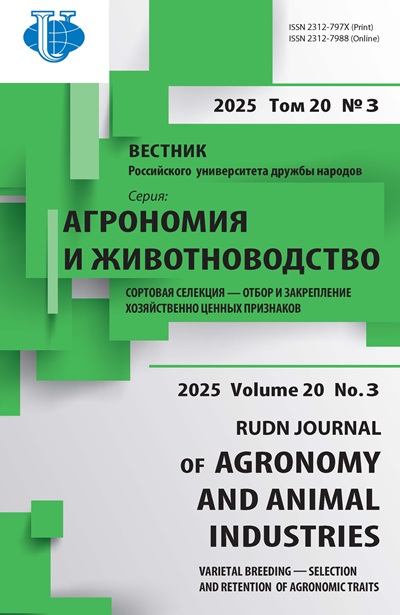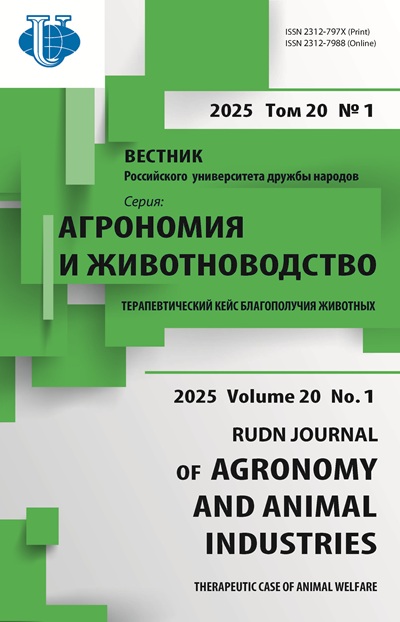Bacell-MT in the diet of dry cows
- Authors: Kotarev V.I.1, Erina T.A.2, Syryev A.A.3
-
Affiliations:
- All-Russian Veterinary Research Institute of Pathology, Pharmacology and Therapy
- Feed Technologies LLC
- Belgorod State Agrarian University named after V. Ya. Gorin
- Issue: Vol 20, No 1 (2025): Therapeutic case of animal welfare
- Pages: 27-37
- Section: Therapeutic case of animal welfare
- URL: https://agrojournal.rudn.ru/agronomy/article/view/20165
- DOI: https://doi.org/10.22363/2312-797X-2025-20-1-27-37
- EDN: https://elibrary.ru/HHCPCT
- ID: 20165
Cite item
Full Text
Abstract
The efficiency of using the feed additive Bacell-MT (the microbial mass of live bacteria Bacillus subtilis 945 (B-5225) in an amount of not less than 1×108 CFU/g, the microbial mass of live bacteria Bacillus amylolique faciens KLS (B-14047) in an amount of not less than 1×108 CFU/g) in the diet of dry cows during their preparation for calving, as well as to increase productivity and improve the condition of the offspring. The studies were conducted on Holstein cows of red-and-white color. The cows were selected on the principle of pairs of analogues and divided into three groups of 20 heads each. The conditions of keeping, feeding and water supply of animals of the experimental and control groups were the same, the only difference was that the experimental groups received the feed additive Bacell-MT, the control group received a basic diet. It was found that the use of Bacell-MT contributes to the safety of livestock, normalization of biochemical parameters of blood, improvement of the quality of milk and offspring. A recommendation is given for the use of probiotic supplements in dry period diets to prevent metabolic disorders and ensure the health of both cows and their offspring.
Keywords
Full Text
Table 1
Experimental design
Group | Number of animals | Duration of the experiment, days | Feeding characteristics |
Control | 20 | 90 | Basic diet (BD) |
Experimental 1 | 20 | 90, including: | BD + Feed additive (FA) "Bacell-MT" 60 g/capita |
60 (before calving) | |||
30 (clinical observations) | Basic diet (BD) | ||
Experimental 2 | 20 | 90, including: | BD + FA "Bacell-MT" 100 g/capita |
60 (before calving) | |||
30 (clinical observations) | Basic diet (BD) |
Source: completed by V.I. Kotarev, T.A. Erina, A.A. Syryev.
Table 2
Animal survival after using the feed additive Bacell-MT in production conditions
Indicators | Group | ||
Control | Experimental 1 | Experimental 2 | |
Number during the experiment, capita | 20 | 20 | 20 |
Number at the end of the experiment, capita | 17 | 20 | 20 |
Culling, capita within 30 days after calving due to: | 3 | 1 | – |
ketosis | 1 | 1 | – |
liver diseases (hepatosis, cirrhosis, fatty liver disease) | 1 | – | – |
abomasum displacement | 1 | – | – |
Culling, % | 15 | 5 | – |
Survivability, % | 85 | 95 | 100 |
Source: completed by V.I. Kotarev, T.A. Erina, A.A. Syryev
Table 3
Key performance indicators on day 30 of lactation
Indicators | Group | ||
Control | Experimental 1 | Experimental 2 | |
Average daily milk yield on day 30 of lactation, kg/day | 25.2 ± 1.2 | 27.5 ± 0.4 | 28.6 ± 0.5 |
Fat, % | 3.82 ± 0.1 | 4.11 ± 0.1 | 4.20 ± 0.1 |
Protein, % | 3.32 ± 0.1 | 3.61 ± 0.1 | 3.83 ± 0.1 |
Somatic cell count, thousand/cm³ | 400 ± 0.2 | 240 ± 0.1 | 200 ± 0.3 |
Source: completed by V.I. Kotarev, T.A. Erina, A.A. Syryev.
Table 4
Biochemical parameters of blood of dairy cows on the 30th day of lactation
Indicator | Group | Normal reference | ||
Control | Experimental 1 | Experimental 2 | ||
ALT, U/L | 45.00 ± 1.17 | 27.00 ± 0.47 | 24.00 ± 0.71 | 5…40 |
AST, U/L | 53.30 ± 6.20 | 35.50 ± 1.40 | 30.70 ± 2.40 | 10…50 |
ALP, U/L | 115.00 ± 0.17 | 107.00 ± 0.14 | 104.00 ± 0.13 | 42…200 |
Cholesterol, mmol/L | 3.15 ± 0.04 | 2.75 ± 0.03 | 1.90 ± 0.05 | 1.3…4.4 |
Glucose, mmol/L | 2.72 ± 0.32 | 2.50 ± 0.14 | 2.50 ± 0.35 | 2.2…3.3 |
Albumin, g/L | 40.40 ± 1.51 | 31.11 ± 1.40 | 30.15 ± 1.1 | 27.5…39.4 |
Total protein, g/L | 90.03 ± 1.41 | 81.17 ± 2.10 | 82.12 ± 1.17 | 72…86 |
Calcium, mmol/L | 2.20 ± 0.04 | 2.60 ± 0.04 | 2.70 ± 0.02 | 2.5…3.1 |
Phosphorus, mmol/L | 1,15 ± 0.20 | 1.15 ± 0.11 | 1.15 ± 0.12 | 1.14…1.29 |
Creatinine, μmol/L | 87.00 ± 1.18 | 80.00 ± 2.40 | 80.00 ± 3.14 | 39.8…120.0 |
Urea, mmol/L | 2,91 ± 0.27 | 4.82 ± 0.25 | 4.72 ± 0.21 | 3.3…6.7 |
Triglycerides, mmol/L | 0.44 ± 0.03 | 0.31 ± 0.01 | 0.31 ± 0.01 | 0.22…0.60 |
Source: completed by V.I. Kotarev, T.A. Erina, A.A. Syryev.
About the authors
Vyacheslav I. Kotarev
All-Russian Veterinary Research Institute of Pathology, Pharmacology and Therapy
Author for correspondence.
Email: kotarev60@ya.ru
ORCID iD: 0000-0003-4411-9372
SPIN-code: 6492-4315
Doctor of Agricultural Sciences, Professor, Chief Researcher
114B Lomonosov st., Voronezh, Russian FederationTatyana A. Erina
Feed Technologies LLC
Email: k_tehnologii@mail.ru
SPIN-code: 3622-2121
Veterinarian-epizootologist, Candidate of Veterinary Sciences, Director 15B Latnenskaya st., Voronezh, Russian Federation
Aleksey A. Syryev
Belgorod State Agrarian University named after V. Ya. Gorin
Email: a.syrev@yandex.ru
PhD student Maiskii, 1 Vavilov st., Belgorod, Russian Federation
References
- Van Saun RJ. Dry cow nutrition: the transition period. Vet Clin North Am Food Anim Pract. 2006;22(2):301-330. doi: 10.1016/s0749-0720 (15) 30785-4
- Grummer RR. Nutritional and management strategies during the transition period to improve the productivity of dairy cows. Anim Prod. 2008;2:624-633.
- D’Angelo SL, Della Rocca G. The role of gut microbiota in dairy cattle health and productivity. Animals. 2023;13(4):655. doi: 10.1146/annurev-animal-021419-083952
- Pinloche E, Le Blou S, Dunière L. Use of probiotics for dairy cows: emphasis on the dry period. Anim Feed Sci Technol. 2020;268:114614. doi: 10.14202/vetworld.2021.319-328
- Mills SJ, Takahashi J, Klajn JL. The effects of probiotic supplementation on rumen fermentation and productivity of dairy cattle: a meta-analysis. J Dairy Sci. 2017;100(3):2240-2255.
- Kotarev VI, Ivanov AA, Petrov SS. Influence of a probiotic supplement on metabolism of cows during the dry period. Vet Med (Moscow). 2020;45(2):12-18. (In Russ.).
- Rastani RR, Grummer RR. Nutritional strategies for improving metabolic health and milk production in transition dairy cows. Appl Anim Sci. 2018;34(6):780-789.
- Nagaraja TG, Newbold KJ. Microbial ecology of the rumen. In: Rumen Microbiology. Cham: Springer; 2020. p. 1-33.
- Goff JP. Monitoring, prevention, and treatment of milk fever and subclinical hypocalcemia in dairy cows. Vet Clin North Am Food Anim Pract. 2008;24(2):243-270. doi: 10.1016/j.tvjl.2007.12.020
- Guan LL, Jenkins TC. Effect of supplemental microbial phytase on phosphorus utilization and milk production in lactating dairy cows. J Dairy Sci. 2000;83(11):2499-2506.
- Swanson KS, Caldwell RB. Effects of a microbial culture and feed additives on nutrient digestibility and productivity in young dairy calves. J Dairy Sci. 2005;88(12):4414-4422.
- Khafipour E, Plaizier JC, Derksen ES. Effects of addition of a live yeast culture on performance and rumen fermentation of periparturient dairy cows. J Dairy Sci. 2009;92(8):3928-3937.
- Morgavi DP, Schwab CG. Probiotics in ruminant nutrition. Anim Feed Sci Technol. 2004;114(1-4):1-28.
- Hristov AN, Jouany JP. Factors affecting ruminal methane production. Anim Feed Sci Technol. 2005;123:553-574.
Supplementary files















